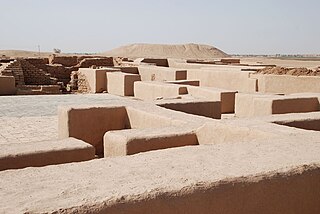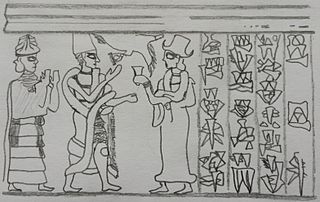Irridu (Irrite) was a city in northwestern Mesopotamia, likely located between Harran and Carchemish. It flourished in the middle and late Bronze Age before being destroyed by Assyria.
The city was first mentioned in a letter from the king of Carchemish to Zimri-Lim of Mari. The letter suggested that Irridu had been a subject of Carchemish, and subsequently it came under the rule of Yamhad. [1]
In the late 18th century BC, Zitraddu, the governor of the city, rebelled against its overlord Yarim-Lim. Consequently, Yarim-Lim's brother, the Great King Abba-El I of Yamhad (c. 1750-1720 BC) quashed the rebels violently to the extent of destroying the city and he compensated his brother by giving him Alalakh. [2]
After the fall of Aleppo, the capital of Yamhad, to the Hittite king Mursili I (c. 1590 BC), Irridu came under the control of Mittani.
During the reign of Šuppiluliuma I of Hatti (c. 1350 BC), under prince Piyassili, [3] occupied Irridu in their advance upon the Mittanian capital Washukanni and after the Hittites retreated, it became a regional center for Mittani until it was conquered by Adad-nirari I, king of Assyria.
King Wasashatta of Mittani rebelled against the Assyrians and sought the help of the Hittites, but received none. Adad-nirari I attacked Mittani and conquered most of its cities. The royal family of Mittani escaped to Irridu but the Assyrians found them and deported them to Assyria.
Irridu and many cities in its area were set on fire, destroyed, and sowed with salty plants. [4]

Babylonia was an ancient Akkadian-speaking state and cultural area based in the city of Babylon in central-southern Mesopotamia. It emerged as an Akkadian populated but Amorite-ruled state c. 1894 BC. During the reign of Hammurabi and afterwards, Babylonia was retrospectively called "the country of Akkad", a deliberate archaism in reference to the previous glory of the Akkadian Empire. It was often involved in rivalry with the older ethno-linguistically related state of Assyria in the north of Mesopotamia and Elam to the east in Ancient Iran. Babylonia briefly became the major power in the region after Hammurabi created a short-lived empire, succeeding the earlier Akkadian Empire, Third Dynasty of Ur, and Old Assyrian Empire. The Babylonian Empire rapidly fell apart after the death of Hammurabi and reverted to a small kingdom centered around the city of Babylon.

Shalmaneser I was a king of Assyria during the Middle Assyrian Empire. He was the son and successor of Adad-nirari I.

Mitanni, earlier called Ḫabigalbat in old Babylonian texts, c. 1600 BC; Hanigalbat or Hani-Rabbat in Assyrian records, or Naharin in Egyptian texts, was a Hurrian-speaking state in northern Syria and southeast Anatolia with Indo-Aryan linguistic and political influences. Since no histories, royal annals or chronicles have yet been found in its excavated sites, knowledge about Mitanni is sparse compared to the other powers in the area, and dependent on what its neighbours commented in their texts.

Yamhad (Yamḫad) was an ancient Semitic-speaking kingdom centered on Ḥalab (Aleppo) in Syria. The kingdom emerged at the end of the 19th century BC and was ruled by the Yamhad dynasty, who counted on both military and diplomacy to expand their realm. From the beginning of its establishment, the kingdom withstood the aggressions of its neighbors Mari, Qatna and the Old Assyrian Empire, and was turned into the most powerful Syrian kingdom of its era through the actions of its king Yarim-Lim I. By the middle of the 18th century BC, most of Syria minus the south came under the authority of Yamhad, either as a direct possession or through vassalage, and for nearly a century and a half, Yamhad dominated northern, northwestern and eastern Syria, and had influence over small kingdoms in Mesopotamia at the borders of Elam. The kingdom was eventually destroyed by the Hittites, then annexed by Mitanni in the 16th century BC.

Qatna was an ancient city located in Homs Governorate, Syria. Its remains constitute a tell situated about 18 km (11 mi) northeast of Homs near the village of al-Mishrifeh. The city was an important center through most of the second millennium BC and in the first half of the first millennium BC. It contained one of the largest royal palaces of Bronze Age Syria and an intact royal tomb that has provided a great amount of archaeological evidence on the funerary habits of that period.
Adad-nārārī I was a king of Assyria during the Middle Assyrian Empire. He is the earliest Assyrian king whose annals survive in any detail, and achieved major military victories that further strengthened Assyria.
Shattuara, also spelled Šattuara, was a king of the Hurrian kingdom of Mittani c. 1305-1285 BC.

The Middle Assyrian Empire was the third stage of Assyrian history, covering the history of Assyria from the accession of Ashur-uballit I c. 1363 BC and the rise of Assyria as a territorial kingdom to the death of Ashur-dan II in 912 BC. The Middle Assyrian Empire was Assyria's first period of ascendancy as an empire. Though the empire experienced successive periods of expansion and decline, it remained the dominant power of northern Mesopotamia throughout the period. In terms of Assyrian history, the Middle Assyrian period was marked by important social, political and religious developments, including the rising prominence of both the Assyrian king and the Assyrian national deity Ashur.

Tell Sheikh Hamad, also Dur-Katlimmu, is an archeological site in eastern Syria on the lower Khabur River, a tributary of the Euphrates.
Yarim-Lim I, also given as Yarimlim, was the second king of the ancient Amorite kingdom of Yamhad in modern-day Aleppo, Syria.
Sumu-Epuh is the first attested king of Yamhad (Halab). He founded the Yamhad dynasty which controlled northern Syria throughout the 17th and 18th centuries BC.
Yarim-Lim III was the king of Yamhad (Halab) succeeding Hammurabi II.
Urshu, Warsuwa or Urshum was a Hurrian-Amorite city-state in southern Turkey, probably located on the west bank of the Euphrates, and north of Carchemish.
Hassum was a Hurrian city-state, located in southern Turkey most probably on the Euphrates river north of Carchemish.
Atarshumki I was the King of Bit Agusi in ancient Syria; he was the son of Arames. The capital of Bit Agusi at that time was Arpad.

Yarim-Lim was a king of Alalakh and son of Hammurabi I of Yamhad. He was granted the city of Alalakh by his brother Abba-El I of Yamhad and started a cadet branch of the Yamhadite dynasty that lasted until the conquest of Alalakh by the Hittite king Hattusili I.

The Yamhad dynasty was an ancient Amorite royal family founded in c. 1810 BC by Sumu-Epuh of Yamhad who had his capital in the city of Aleppo. Started as a local dynasty, the family expanded its influence through the actions of its energetic ruler Yarim-Lim I who turned it into the most influential family in the Levant through both diplomatic and military tools. At its height the dynasty controlled most of northern Syria and the modern Turkish province of Hatay with a cadet branch ruling in the city of Alalakh.

The timeline of ancient Assyria can be broken down into three main eras: the Old Assyrian period, Middle Assyrian Empire, and Neo-Assyrian Empire. Modern scholars typically also recognize an Early period preceding the Old Assyrian period and a post-imperial period succeeding the Neo-Assyrian period.
The Battle of Kār Ištar was fought between Assyria and the Kassites of Babylon sometime during the reign of Assyrian king Adad-nirari I.